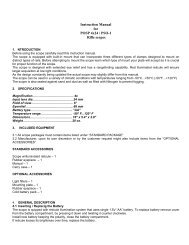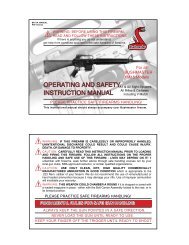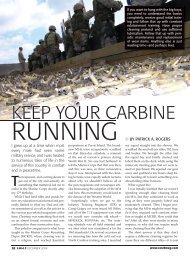FM 21-76 US ARMY SURVIVAL MANUAL - AR15.com
FM 21-76 US ARMY SURVIVAL MANUAL - AR15.com
FM 21-76 US ARMY SURVIVAL MANUAL - AR15.com
Create successful ePaper yourself
Turn your PDF publications into a flip-book with our unique Google optimized e-Paper software.
<strong>FM</strong> <strong>21</strong>-<strong>76</strong> <strong>US</strong> <strong>ARMY</strong> <strong>SURVIVAL</strong> <strong>MANUAL</strong> Reprinted as permitted by U.S. Department of the Army<br />
You must not try to swim or wade across a stream or river when the water is at very low temperatures.<br />
This swim could be fatal. Try to make a raft of some type. Wade across if you can get only your feet wet.<br />
Dry them vigorously as soon as you reach the other bank.<br />
RAPIDS<br />
If necessary, you can safely cross a deep, swift river or rapids. To swim across a deep, swift river, swim<br />
with the current, never fight it. Try to keep your body horizontal to the water. This will reduce the danger<br />
of being pulled under.<br />
In fast, shallow rapids, lie on your back, feet pointing downstream, finning your hands alongside your<br />
hips. This action will increase buoyancy and help you steer away from obstacles. Keep your feet up to<br />
avoid getting them bruised or caught by rocks.<br />
In deep rapids, lie on your stomach, head downstream, angling toward the shore whenever you can.<br />
Watch for obstacles and be careful of backwater eddies and converging currents, as they often contain<br />
dangerous swirls. Converging currents occur where new watercourses enter the river or where water has<br />
been diverted around large obstacles such as small islands.<br />
To ford a swift, treacherous stream, apply the following steps:<br />
• Remove your pants and shirt to lessen the water's pull on you. Keep your footgear on to protect<br />
your feet and ankles from rocks. It will also provide you with firmer footing.<br />
• Tie your pants and other articles to the top of your rucksack or in a bundle, if you have no pack.<br />
This way, if you have to release your equipment, all your articles will be together. It is easier to<br />
find one large pack than to find several small items.<br />
• Carry your pack well up on your shoulders and be sure you can easily remove it, if necessary.<br />
Not being able to get a pack off quickly enough can drag even the strongest swimmers under.<br />
Find a strong pole about 7.5 centimeters in diameter and 2.1 to 2.4 meters long to help you ford the<br />
stream. Grasp the pole and plant it firmly on your upstream side to break the current. Plant your feet<br />
firmly with each step, and move the pole forward a little downstream from its previous position, but still<br />
upstream from you. With your next step, place your foot below the pole. Keep the pole well slanted so<br />
that the force of the current keeps the pole against your shoulder (Figure 17-1).<br />
• Cross the stream so that you will cross the downstream current at a 45-degree angle.<br />
Using this method, you can safely cross currents usually too strong for one person to stand against. Do<br />
not concern yourself about your pack's weight, as the weight will help rather than hinder you in fording<br />
the stream.<br />
If there are other people with you, cross the stream together. Ensure that everyone has prepared their<br />
pack and clothing as outlined above. Position the heaviest person on the downstream end of the pole<br />
and the lightest on the upstream end. In using this method, the upstream person breaks the current, and<br />
those below can move with relative ease in the eddy formed by the upstream person. If the upstream<br />
Page 186 of 233








